Places to Visit in and near by Ahmedabad City
Heritage Site

About the location :
Bai Harir ni Vav lies 15 km from the centre of Ahmedabad city. This step-well, built in 1499 under the supervisor of Sultan Begada’s harem, has steps down through five levels of carved stone columns to two small wells, now often bone dry. The depths are cool, even on the hottest day, and it’s a fascinating and eerie place. Overflow channels at the top are a reminder of times when water tables were much higher than today. Behind the step-well, the 16th-century Dai Halima Mosque contains the mausoleum of a royal midwife named Halima, with elegant jali screens. The monument is off the beaten track and is one of the most soothing locations of the city.Brief History :
Persian and Sanskrit inscriptions on the walls tell the legend of the monument. It is said that Dhai Harir (also known as Bai Harir Sultani), a household lady of Mahmud Begada, commissioned this stepwell. She built a mosque alongside and a small tomb, in which she was buried.Weekend Get-aways
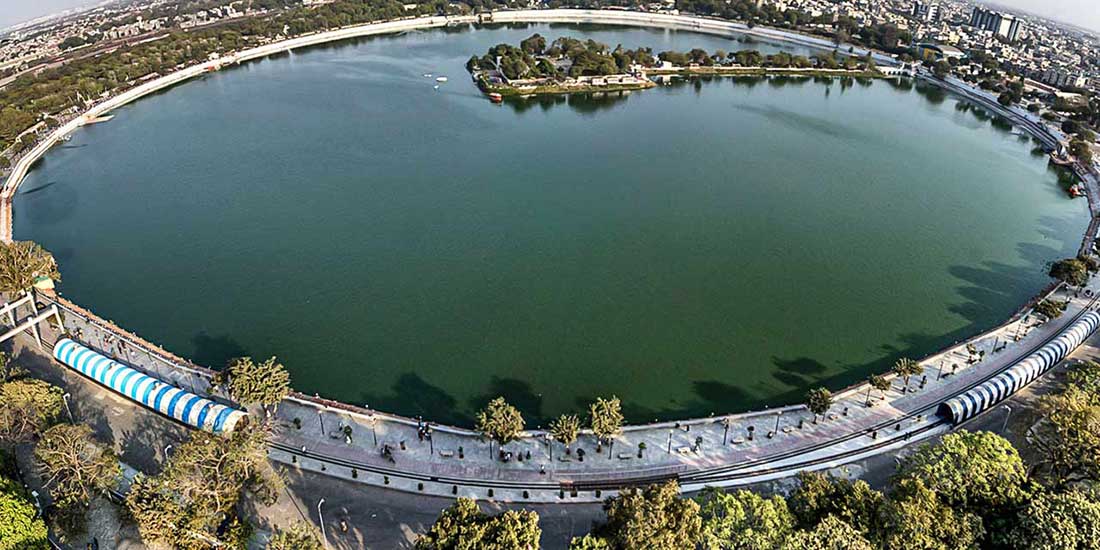

About the location :
Built in 1451 as Hauz e Qutub, and recently converted as a recreation space for the city, this large lake is a good respite from the hectic streets. In fact, this is the second largest lake of Ahmedabad, offering a pleasing visual break from the buildings and roads. Attractions include a tethered hot-air balloon (10min ride Rs 100; 10am–10pm), a mini-train and the Kamla Nehru Zoo (entry/camera Rs 20/5; Mar–Oct 9am–6.15pm and Nov–Feb 9am–5.30pm). One Tree Hill Garden on the west side (entered from outside) contains some quite grand colonial Dutch tombs. There are additional trappings of a public entertainment space that can keep kids hooked for hours.Brief History :
The origin of Kankaria Lake goes back to Chalukyan times. According to the 14th century chronicler Merutunga, the Chalukya ruler Karna built a temple dedicated to the goddess Kochharba. He also established the Karnavati city close to Ahmedabad, where he commissioned the Karnamukteshwara and Jayantidevi temples. The king also built the Karnasagara tank at Karnavati next to Karneshvara Temple. They say Karnasagar tank is today’s Kankaria Lake. Though the construction was started by lake started by Sultan Muizz-ud-Din Muhammad Shah II, it was completed in 1451 in Ahmedabad’s architectural golden period by Sultan Qutb-ud-Din Ahmad Shah II. Researchers say that the name Hauj-e-Qutb (the tank of Qutb) after the Sultan Qutb-ud-Din was the original name of the lake.Historians believe that the lake gets its name from the large quantities of limestone (kankar in Gujarati) that was dug out of it during excavation. Another story narrates that the Sultan Qutb-ud-Din asked Saint Shah Alam to select the site for a tank and a garden in his kingdom. The saint scattered some pebbles on the site, which was later excavated and the lake was built on the exact spot. A different story leans towards the saint Hazrat-i-Shah Alam’s saga, in which he cut his foot on a sharp pebble while passing through excavation. The lake was then called Kankaria or full of pebbles.

About The Location
Sabarmati River has been an integral part in the life of Ahmedabad since the time the city was founded in 1411 along the river banks. Sabarmati Riverfront project has proved to be a major Urban Asset and adds another feather in the cap. Both, the residents of the city and the visiting tourists have the pleasure to visit verious places.
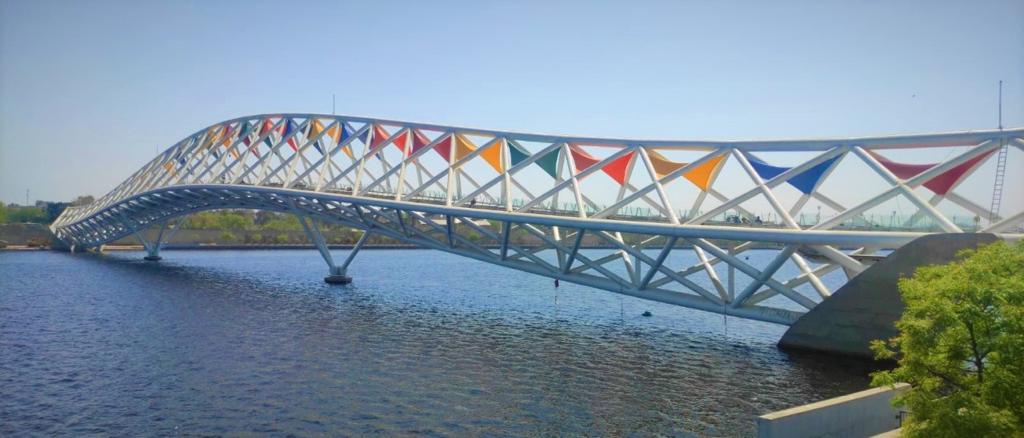
Atal Bridge
This iconic Atal bridge is first of its kind in the country. It will connect west and east part of Sabarmati Riverfront. It has drawn inspiration from the Kites and the celebration of Uttrayan. Even the colours chosen reflects the hues of kites. To feel the joy of walking above the river, this glass Atal bridge is constructed between Sardar Bridge and Ellis Bridge. The bridge is solely for the walking purpose and also having seating arrangements for the people to enjoy the beauty of the river from the bridge. Plantation of various trees are also done to have some green cover on the bridge.
Gandhi Circuit
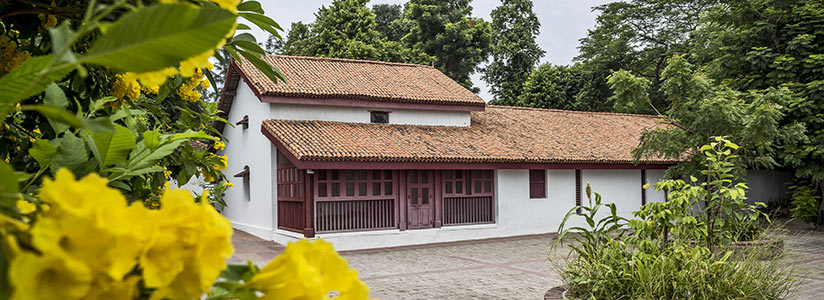
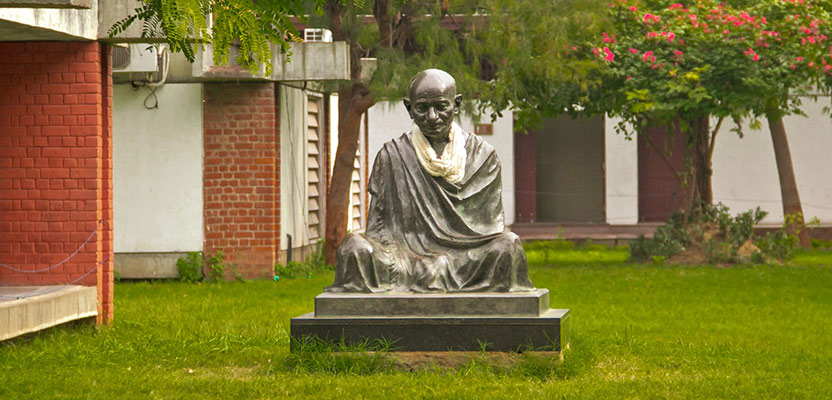
Timing : 10:00 AM to 6:00 PM (Ashram is open every day of the Year)
About the location :
Sabarmati Ashram in Gujarat, located north of Ahmedabad, was originally the residence of Mahatma Gandhi and his spouse Kasturba. The ashram is flanked by a calm and quiet stretch by the Sabarmati River. This is also the location where Gandhi started his Dandi March from. Because it was located in between a prison and a cemetery, Gandhi believed that a Satyagrahi would certainly end his life in either a prison or a graveyard. Sabarmati Ashram will reawaken your sense of independence. The museum is the most well-known of the many institutions within the Sabarmati ashram's grounds.Various personal letters and images of Gandhi are displayed throughout the space. Upasana Mandir, Magan Niwas, Vinoba, Nandini, and Kutir are some of the ashram's other structures. The ashram is now a historical site, having witnessed numerous historical occurrences. You can also visit this place and learn more about India's ancient history.
History :
The original ashram was founded in May 1915 at Jivanlal Desai's Kochrab Bungalow (approximately 10 kilometers from here), who was a barrister associate of Gandhi, as Satyagraha Ashram. Mahatma Gandhi required additional space to carry out tasks such as farming and animal husbandry so it was transferred to a 36-acre site on the banks of the river Sabarmati on June 17, 1917.Museums

Visiting Hours : 9.30am–5pm and 3D show 7–7.45pm (Mon closed)
Location : Ahmedabad
About the location :
Creating history on an already hallowed address of an erstwhile palace (Moti Shahi Mahal), this is one of the most underrated experiences of Ahmedabad. The museum is a rich repository of Patel’s life arc as a political leader and thinker, while giving considerable space to other luminaries who crossed his path – namely Rabindranath Tagore, who stayed here at the age of seventeen. Contemporary technology backs the interactive exhibits with clear, concise and well researched audio-visual displays.Brief History :
The museum stands on the same address as Moti Shahi Mahal, a palace built by the Mughal Emperor Shahjahan between 1618 and 1622. One of the biggest inclusions for ornamentation included the Shahibaug gardens that were brimming with noble cypresses, cedars, palms, sandals, and cassias, with mango, tamarind, and other fruit trees. The palace fell into the hands of the British and was used as a government building. Post-independence, the structure became Raj Bhavan, the official residence of the Governor of Gujarat, from 1960 to 1978. It was declared a memorial for Sardar Vallabhbhai Patel on his centennial birth anniversary on 7 March 1980.Religious Sites
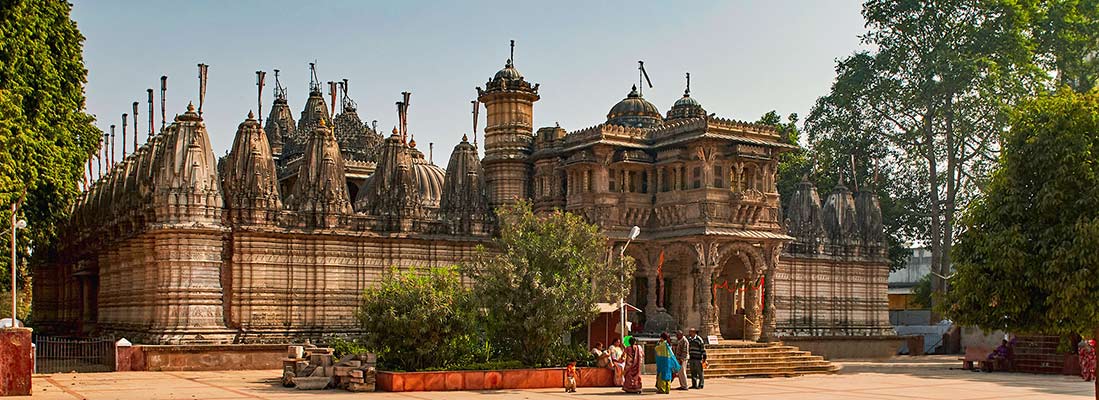
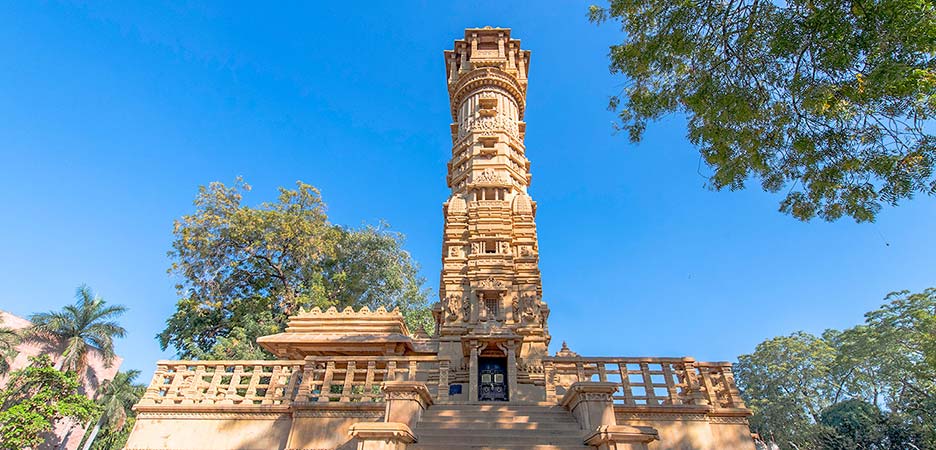
About The Place :This remarkably elegant temple created out of white marble has been sacred to many Jain families, generation after generation. It was built in 1848 A.D. at an estimated cost of 10 lakh rupees by a rich merchant Sheth Hutheesing as a dedication to the 15th Jain Tirthankara, Shri Dharmanatha. Traditional artisans working in stone belonged to the Sonpura & Salat communities. The Salat community constructed masterpieces of architecture ranging from forts, palaces to temples. The work of the Hutheesing Jain temple is attributed to Premchand Salat. One scholar has remarked, "Each part goes on increasing in dignity as we approach the sanctuary. Whether looked at from its courts or from the outside, it possesses variety without confusion and appropriateness of every part to the purpose for which it was intended."
Located outside the Delhi Gate, the temple is spread over a sprawling courtyard, a mandapa surmounted by a large ridged dome, which is supported by 12 ornate pillars. The small garbhagruh (main shrine) on the east end reaches up into three stunningly carved spires and encircled by 52 small shrines dedicated to the various Tirthankars. There are large protruding porches with magnificently decorated columns and figural brackets on three outer sides. Also, a recently built 78 ft Mahavir stambha (tower) fashioned after the renowned tower at Chittor in Rajasthan, flanks the outer courtyard by the front entrance. Some of the motifs used in the design remind one of the Sultanate minarets of the Mughal period.
Ahmedabad Heritage Walk
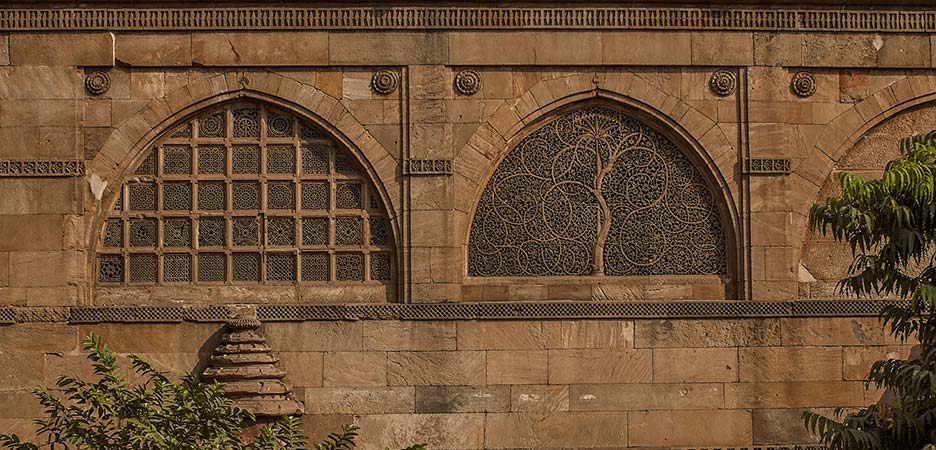
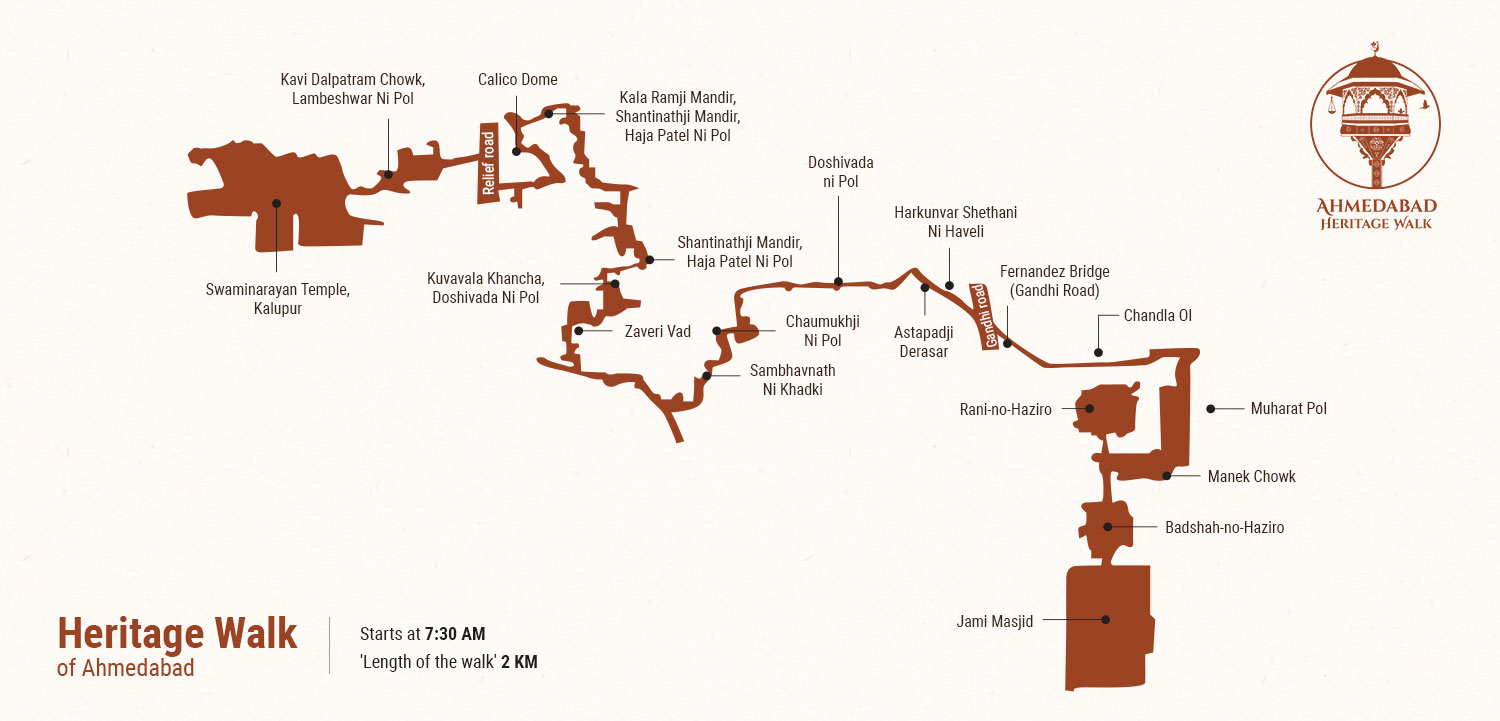
On the ancient site of Ashaval and Karnavati, Ahmedabad was found on 1411. The City of Ahmedabad has some of the finest India, Islamic monuments and exquisite Hindu and Jain temples. Its carved wooden houses are another unique architectural tradition.
A special feature of Ahmedabad is the plan of the old city comprising numerous pols, self-contained neighborhoods, sheltering large numbers of peoples. Some of these virtually small villages, traversed by narrow streets, usually terminating in square with community wells and chabutaras for feeding birds, gates, Cul-de-sacs and secret passages. To experience the glory of Ahmedabad, it is necessary to walk through an old quarter and truly observe the nature of its architecture, its art, religious places, its culture and traditions.
With the purpose of unveiling the city to the tourists and the citizens themselves, Ahmedabad Municipal Corporation has arranged this HERITAGE WALK OF AHMEDABAD.
For more updates you can visit on Website : Click Here
Route : From Kalupur Swaminarayan Temple at 07:45 a.m. daily and terminates at Jumma Masjid at 10.30 a.m.
Indus Valley Civilization Sites
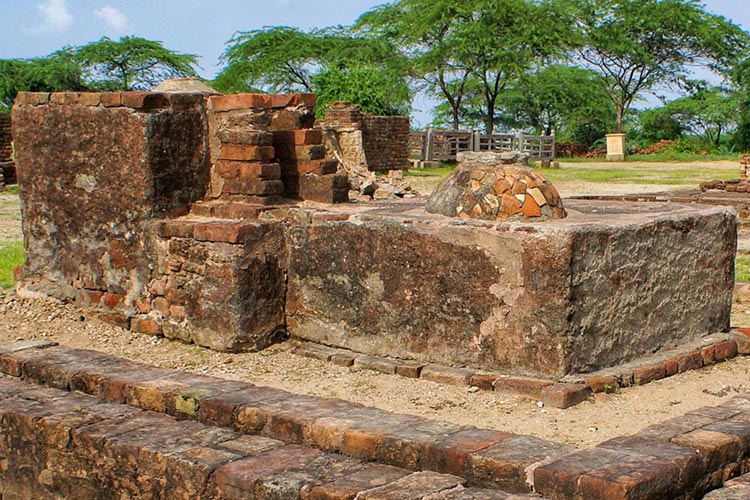
Note : You can book ticket using Click Here
Visiting Hours : Every Friday Closed
Location : Ahmedabad
About the location :
About 80km southwest of Ahmedabad, the city that stood at this archaeological site 4500 years ago was one of the most important of the Indus Valley civilisation, which extended into what is now Pakistan. Excavations have revealed the world’s oldest known artificial dock, which was connected to an old course of the Sabarmati River. Other features include the acropolis, the lower town, the bead factory, the warehouses, and the drainage system. The site has been nominated to be enlisted as a UNESCO World Heritage Site. The traveller can see fascinating finds by archeologists like canals and dockyards that explain how this was an important trading city. Artefacts suggest that trade may have been conducted with Mesopotamia, Egypt and Persia. An entire township with market and dock has been unearthed here. An Archaeological Museum (10am–5pm, Friday closed) near the site houses a number of artefacts like jewellery, pottery, seals, religious symbols, and objects of daily use here.Brief History :
It is said that Lothal is a combination of two words; Loth and thal, which in Gujarati means ‘the mound of the dead.’ The city was inhabited during 3700 BCE and was a thriving trading port. The excavation started from 13 February 1955 to 19 May 1960 by the Archaeological Survey of India (ASI) to unearth the ancient city. Archaeologists believe that the city was a part of a major river system on the ancient trade route from Sindh to Saurashtra in Gujarat. Excavations here have offered the greatest number of antiquities in the archaeology of modern India.